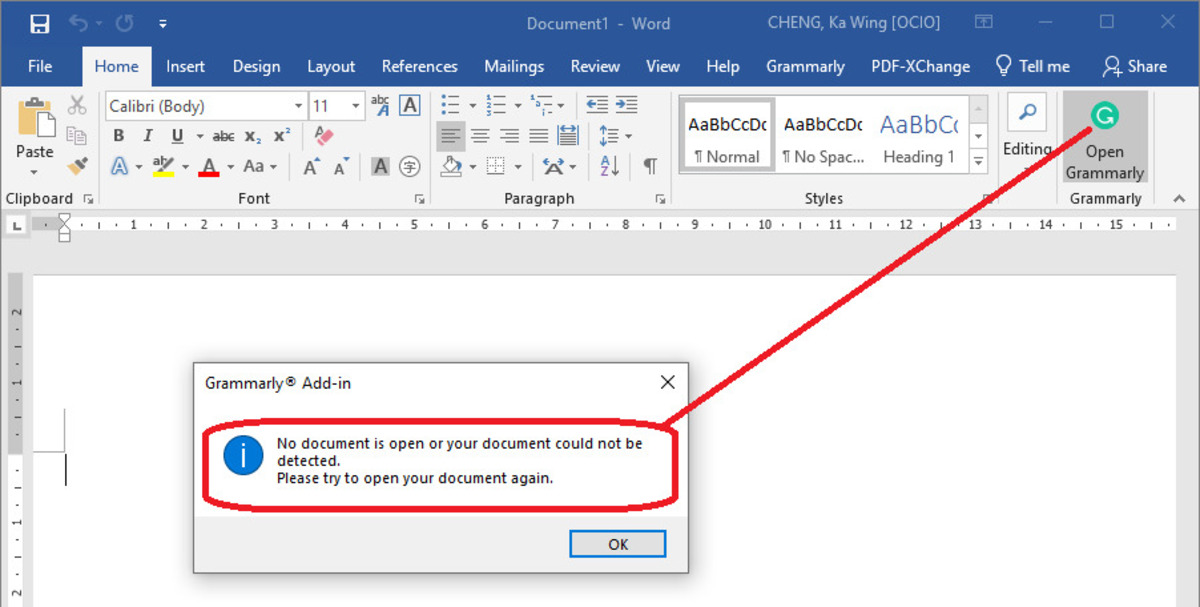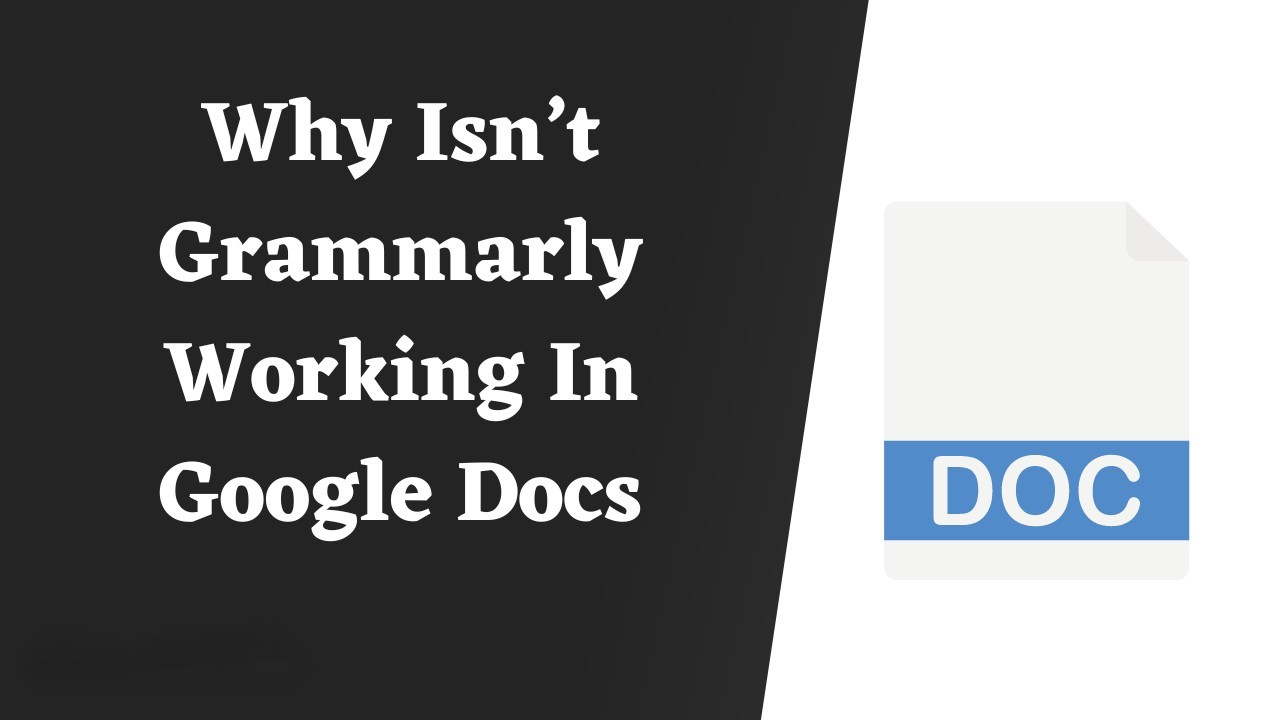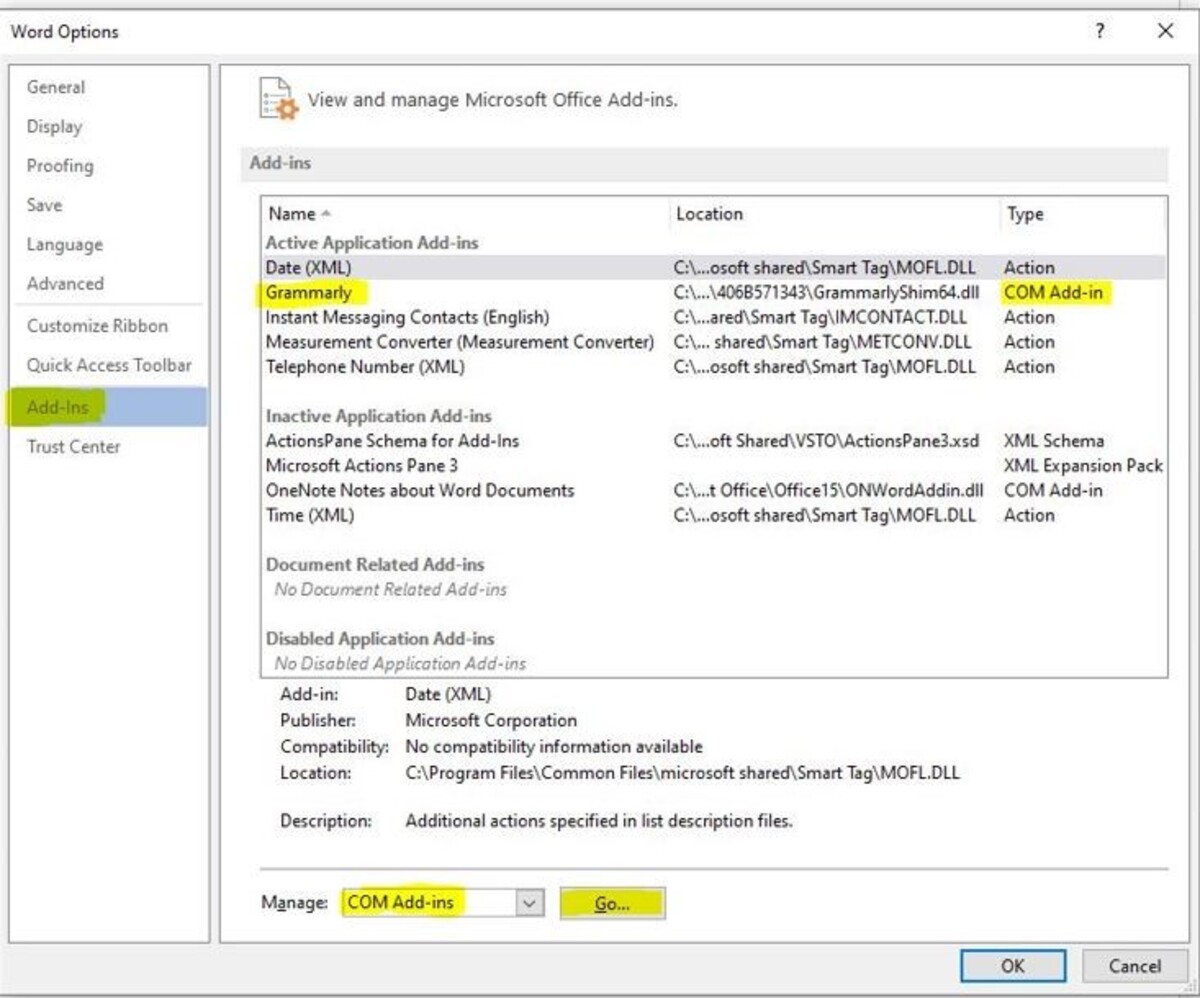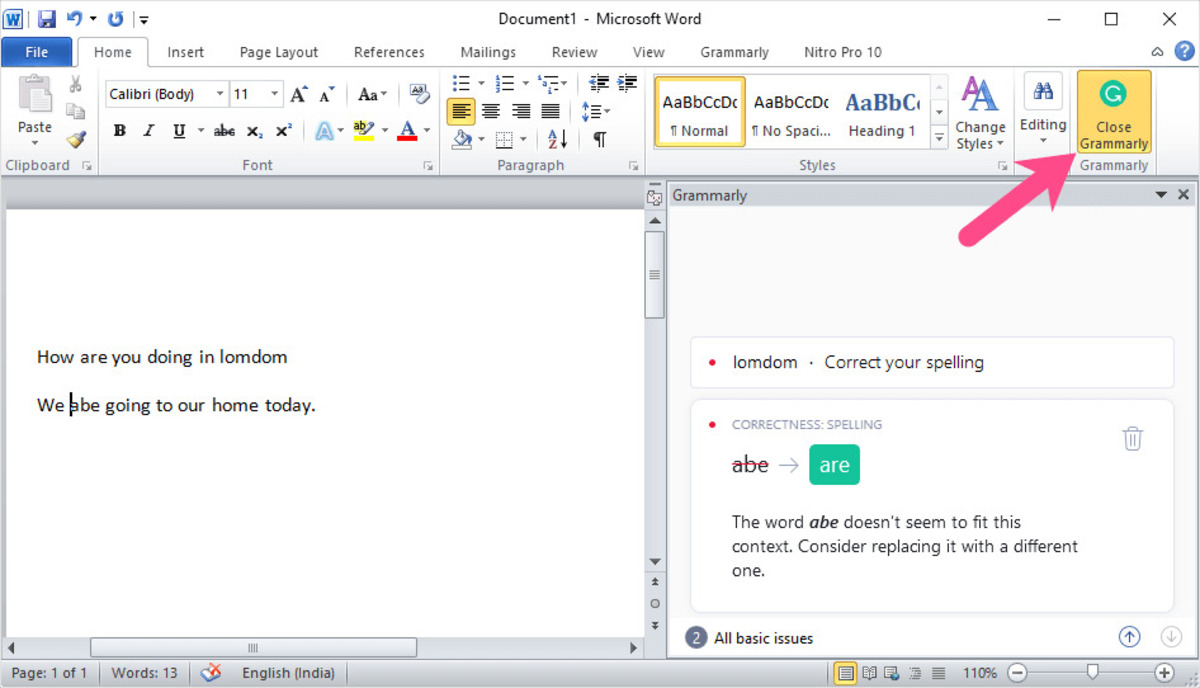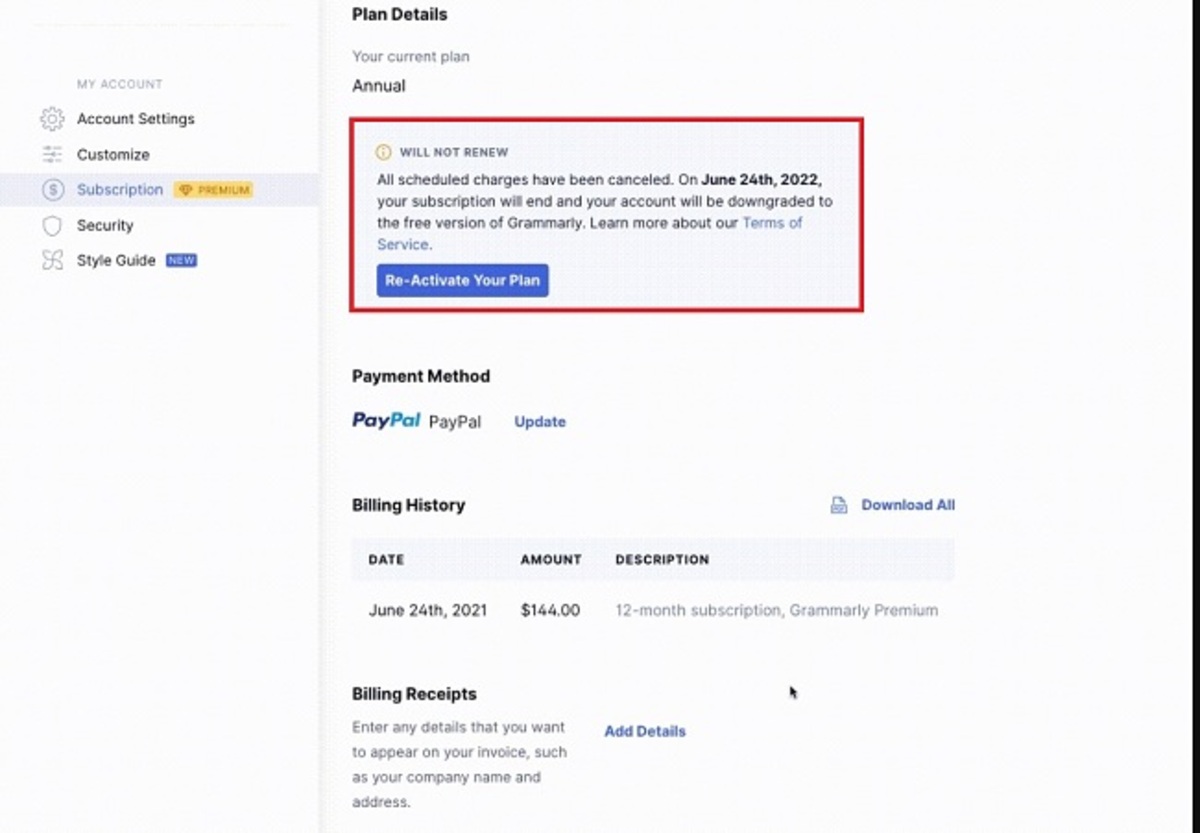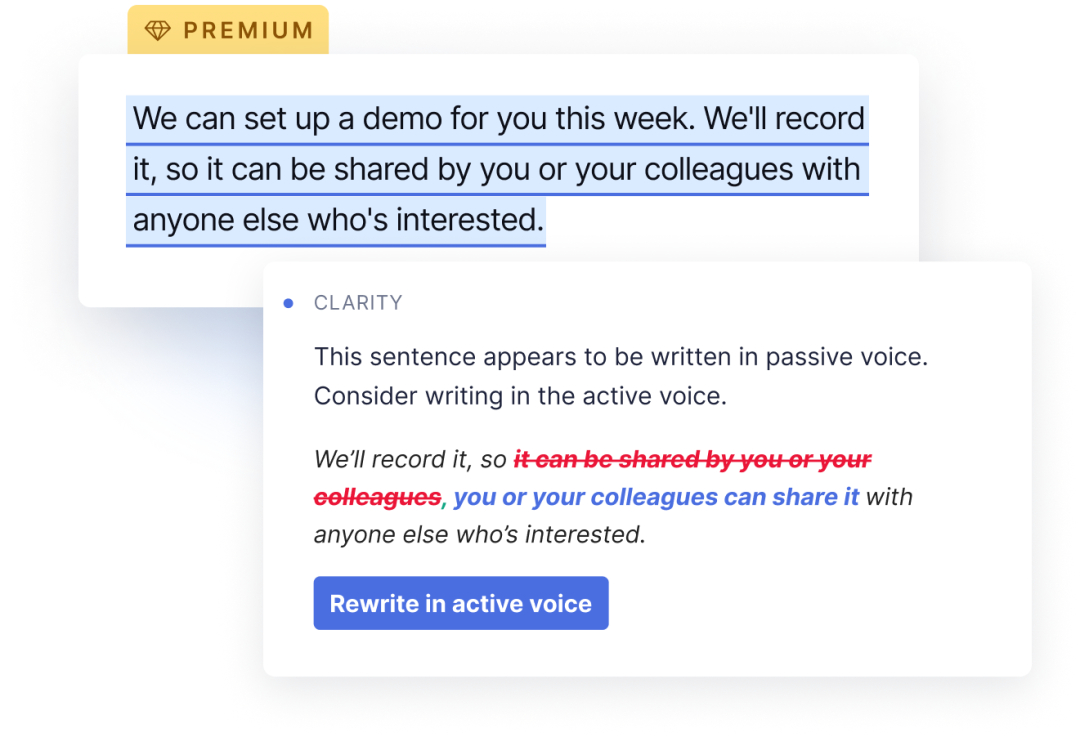Why Isn’t My Grammarly Working
Grammarly is a powerful tool that helps you enhance your writing by detecting grammar and spelling errors, providing suggestions for improvements, and offering advanced writing insights. However, there may be instances when you encounter issues with Grammarly not working as expected. Understanding the reasons behind these problems can help you troubleshoot and resolve them effectively.
There are several common reasons why Grammarly may not be functioning properly. These include:
- Technical issues
- Compatibility issues
- Network connection problems
Technical issues can arise due to various factors such as software conflicts, outdated browser versions, or corrupted Grammarly extensions. Compatibility issues can occur if Grammarly is not designed to work with a particular software or platform. Network connection problems, on the other hand, can hinder Grammarly’s ability to communicate with its server and provide accurate feedback.
If you are experiencing issues with Grammarly, don’t worry. There are some troubleshooting steps you can take to resolve the problem:
- Clear browser cookies and cache: Clearing your browser’s cookies and cache can help refresh the connection and resolve any potential conflicts that may be affecting Grammarly’s performance.
- Disable other browser extensions: Certain browser extensions may interfere with Grammarly’s functionality. Temporarily disabling them can help identify if any conflicts are occurring.
- Update or reinstall Grammarly extension: Ensure that you are using the latest version of the Grammarly extension. If not, update it to the latest version. If the issue persists, consider uninstalling and reinstalling the Grammarly extension.
- Check for Grammarly updates: Grammarly regularly releases updates to improve its functionality and address any bugs. Make sure you have the latest updates installed.
- Contact Grammarly support: If you have tried the above steps and are still facing issues with Grammarly, it is advisable to reach out to Grammarly’s support team for further assistance. They can provide personalized support and guide you through the troubleshooting process.
By following these troubleshooting steps, you can often resolve most issues with Grammarly not working. However, if the problem persists, it’s important to contact Grammarly support for additional help and guidance. Remember, Grammarly is a valuable tool that can significantly enhance your writing, so it’s worth addressing any issues and getting it back up and running smoothly.
Introduction
Effective communication is key in today’s fast-paced digital world, and writing plays a crucial role in conveying ideas, thoughts, and information. To ensure that your writing is clear, concise, and error-free, Grammarly, the popular writing assistant tool, comes to the rescue. However, there may be times when you face the frustrating situation of Grammarly not working as expected.
Grammarly is designed to be a user-friendly and reliable tool, but just like any software, it can encounter issues that impact its functionality. Understanding the common reasons behind Grammarly not working can help you troubleshoot and resolve the problem, ensuring that you can continue to produce high-quality content.
In this article, we will explore the reasons why Grammarly may not be working and provide you with practical troubleshooting steps to get it back on track. Whether you are a professional writer, student, or someone who relies on Grammarly to improve their writing, this guide will help you overcome any obstacles you may encounter.
Before diving into the troubleshooting steps, it’s important to note that Grammarly is continually improving and releasing updates to enhance its performance and user experience. Thus, some issues can be resolved by simply ensuring that you have the latest version of the Grammarly extension installed, making it necessary to check for updates regularly.
Now, let’s delve into the common reasons why Grammarly may not be working and explore the step-by-step troubleshooting process to address these issues effectively. By following these guidelines, you can get your Grammarly tool up and running, allowing you to write with confidence and clarity.
Common Reasons for Grammarly Not Working
While Grammarly is a reliable writing assistant, there are several reasons why it may not work as expected. Understanding these common reasons can help you identify and resolve any issues you may encounter. Let’s explore some of the main ones:
- Technical issues: Technical problems can occur due to conflicts with other software or extensions installed on your computer. Outdated browser versions or corrupted Grammarly extensions can also hinder its performance.
- Compatibility issues: Grammarly works seamlessly with most popular writing platforms, but there may be instances where it is not fully compatible with certain software or platforms. This can result in reduced functionality or errors.
- Network connection problems: Grammarly relies on an internet connection to function properly. If you have a weak or unstable network connection, it may impact the tool’s ability to access its servers and provide accurate feedback.
- Account-related issues: Sometimes, problems may arise from your Grammarly account itself, such as billing issues, account suspension, or restrictions imposed by Grammarly for policy violations.
By being aware of these common reasons, you can narrow down the potential causes of Grammarly not working and take targeted steps to troubleshoot and resolve the issue.
Now that we have addressed the common reasons for Grammarly not working, let’s move on to the next section, where we will explore the technical issues in more detail and provide specific troubleshooting steps to get your Grammarly tool back on track.
Technical Issues
Technical issues can often cause Grammarly to malfunction or not work as expected. These issues can be caused by various factors, ranging from software conflicts to outdated browser versions or corrupted Grammarly extensions. Let’s examine some of the technical issues commonly encountered when using Grammarly and explore troubleshooting steps to address them:
1. Software conflicts: Occasionally, conflicts can arise between Grammarly and other software or browser extensions installed on your computer. These conflicts may affect Grammarly’s functionality, causing it to stop working or produce errors. To resolve this issue, try disabling other browser extensions temporarily to identify any potential conflicts. If disabling the extensions resolves the problem, you can selectively enable them one by one to pinpoint which extension is causing the conflict.
2. Outdated browser versions: An outdated browser version can also impact Grammarly’s performance. Ensure that you are using the latest version of your preferred browser. Browsers like Chrome, Firefox, and Edge frequently release updates with bug fixes and performance improvements. Updating your browser to the latest version can often resolve compatibility issues and ensure a smoother Grammarly experience.
3. Corrupted Grammarly extensions: Over time, an extension can become corrupted, leading to issues with functionality. If Grammarly suddenly stops working or behaves erratically, consider reinstalling the Grammarly extension. First, remove the existing extension from your browser, then visit the browser’s extension store (e.g., Chrome Web Store) to download and install the latest version of the Grammarly extension.
4. Browser-specific issues: Different browsers may present unique challenges when it comes to Grammarly. You may find that Grammarly functions perfectly in one browser but encounters problems in another. If Grammarly is not working correctly on your preferred browser, try using it with an alternative browser to see if the issue persists. This can help identify whether the problem is specific to the browser you are currently using or is more widespread.
By addressing these technical issues and following the troubleshooting steps provided, you can often resolve most problems related to Grammarly not working. However, it’s essential to remember that sometimes the issue may be more complex and require further assistance. In the next section, we will explore compatibility issues and discuss additional troubleshooting steps to overcome them.
Compatibility Issues
While Grammarly strives to be compatible with a wide range of platforms and software, there may still be instances where it encounters compatibility issues. These issues can arise due to differences in software configurations, conflicts with specific writing platforms, or limitations imposed by certain operating systems. Let’s explore some common compatibility issues with Grammarly and discuss potential solutions:
1. Writing platform limitations: Grammarly integrates seamlessly with popular writing platforms, such as Microsoft Word, Google Docs, and WordPress. However, certain limitations may exist when using Grammarly with less common or specialized writing platforms. If you are experiencing issues with Grammarly not functioning properly on a specific writing platform, reach out to Grammarly support or consult their documentation to determine if there are any known limitations or workarounds.
2. Operating system compatibility: Grammarly is designed to work on various operating systems, including Windows, macOS, and Linux. However, it’s important to ensure that you are using a compatible operating system version to avoid potential issues. Check Grammarly’s system requirements and verify that your operating system meets the specified criteria.
3. Web browser compatibility: Grammarly supports popular web browsers like Chrome, Firefox, Safari, and Edge. However, occasional compatibility issues may arise, particularly with browser updates or beta versions. If Grammarly is not working correctly on your browser, try using a different browser to determine if the issue is specific to the browser being used. Additionally, ensure that you have the latest version of the browser installed to minimize compatibility issues.
4. Mobile device limitations: While there is a Grammarly app available for mobile devices, its functionality and features may be limited compared to the desktop version. Some writing platforms may not have full compatibility with Grammarly on mobile devices, leading to potential issues. If you encounter problems with Grammarly on your mobile device, consider using Grammarly on a desktop or laptop for a more comprehensive writing experience.
By being aware of these compatibility issues and exploring potential solutions, you can overcome hurdles when Grammarly is not working as expected on specific platforms or operating systems. It’s also advisable to keep your software and operating systems up to date and regularly check for Grammarly updates, as these updates often address compatibility issues and improve overall performance.
In the next section, we will address network connection problems and provide troubleshooting steps to help you resolve them effectively.
Network Connection Problems
A stable and reliable network connection is essential for Grammarly to function correctly. Network connection problems can hinder Grammarly’s ability to communicate with its servers and provide accurate feedback. Let’s explore some common network connection issues and discuss troubleshooting steps to resolve them:
1. Weak or unstable internet connection: A weak or unstable internet connection can disrupt the flow of data between your computer and Grammarly’s servers. This can result in delayed responses, error messages, or difficulties accessing Grammarly’s features. To address this issue, try connecting to a more stable network, such as a wired connection or a different Wi-Fi network. Alternatively, contacting your internet service provider (ISP) to diagnose and resolve any connectivity issues may be necessary.
2. Network restrictions or firewall settings: In some cases, network restrictions or firewall settings may prevent Grammarly from fully functioning. Firewalls and network security measures are designed to protect your computer from external threats but can inadvertently block or interfere with certain internet connections. To resolve this issue, consult with your network administrator or adjust your firewall settings to allow Grammarly’s connection.
3. Proxy server or VPN limitations: If you are using a proxy server or a virtual private network (VPN), it’s possible that these configurations may affect Grammarly’s ability to connect to its servers. Proxy servers and VPNs can alter your IP address and route your internet traffic through different servers, potentially causing connectivity issues. Try disabling the proxy server or VPN temporarily to see if the problem resolves. If Grammarly works without them, consider adjusting the settings or contacting the proxy server or VPN provider for assistance.
4. Browser security settings: Some browser security settings may restrict Grammarly’s functionality or block certain features. Check your browser’s security settings and ensure that Grammarly is not blocked or restricted. Adjusting the settings to allow all necessary connections can often resolve issues related to network connectivity.
5. Grammarly server maintenance: Periodically, Grammarly may conduct server maintenance or updates that can temporarily affect its functionality. During such times, you may experience limited access to certain features or encounter slower response times. It’s recommended to check Grammarly’s official website or social media channels for any announcements regarding planned maintenance.
By addressing these network connection issues and following the troubleshooting steps provided, you can often resolve most network-related problems with Grammarly. It’s important to ensure that you have a reliable and stable network connection to fully utilize Grammarly’s features and benefits.
Next, we will move on to discuss specific troubleshooting steps to help you resolve issues related to Grammarly not working, starting with clearing browser cookies and cache.
Troubleshooting Steps
When you encounter issues with Grammarly not working, there are several troubleshooting steps you can take to resolve the problem. These steps are designed to address common issues and restore Grammarly to its optimal functionality. Let’s explore these troubleshooting steps:
- Clear browser cookies and cache: Over time, accumulated cookies and cache files can impact Grammarly’s performance. Clearing your browser’s cookies and cache can help refresh the connection and resolve any potential conflicts. Go to your browser’s settings and find the option to clear cookies and cache. Restart the browser and check if Grammarly is now working properly.
- Disable other browser extensions: Certain browser extensions may interfere with Grammarly’s functionality. Temporarily disable other extensions one by one to identify if any of them are causing conflicts. If disabling a specific extension resolves the issue, consider removing or replacing it with an alternative.
- Update or reinstall Grammarly extension: Ensure that you have the latest version of the Grammarly extension installed. Outdated versions may cause compatibility issues or contain bugs. Visit your browser’s extension store (e.g., Chrome Web Store) to check for updates. If the issue persists, consider uninstalling and reinstalling the Grammarly extension.
- Check for Grammarly updates: Grammarly regularly releases updates to improve performance and address bugs. Make sure you have the latest updates installed to benefit from the latest features and enhancements. Check Grammarly’s website or automatically update the extension if available.
- Contact Grammarly support: If the troubleshooting steps mentioned above do not resolve the issue, it may be necessary to contact Grammarly support for further assistance. Grammarly’s support professionals can provide personalized support and guide you through the troubleshooting process. Be sure to provide detailed information about the problem and steps you have already taken to resolve it.
Remember to follow these troubleshooting steps systematically and try each one individually before moving on to the next. This will help you identify the specific cause of the issue and find the most appropriate solution.
By applying these troubleshooting steps, you can often resolve most issues with Grammarly not working. However, if the issue persists or if you encounter unique circumstances, it’s best to reach out to Grammarly support for personalized assistance.
Now that we have covered the troubleshooting steps, we will conclude by summarizing the key points discussed earlier in this article.
Clear Browser Cookies and Cache
Clearing your browser’s cookies and cache is an essential troubleshooting step when Grammarly is not working as expected. Over time, your browser accumulates cookies and cache files that can impact the performance of Grammarly. Clearing these files helps refresh the connection and resolve any potential conflicts. Let’s dive into the steps to clear browser cookies and cache:
- Chrome: Click on the three-dot menu in the top-right corner, go to “More tools,” and select “Clear browsing data.” Choose a time range, such as “Last hour” or “All time,” and make sure the options for “Cookies and other site data” and “Cached images and files” are selected. Click “Clear data” to clear the cookies and cache.
- Firefox: Go to the three-line menu in the top-right corner, select “Options,” and go to the “Privacy & Security” tab. Under “Cookies and Site Data,” click on “Clear Data.” Ensure that the options for “Cookies” and “Cache” are checked, then click “Clear” to clear the cookies and cache.
- Safari: In the top menu, click on “Safari” and select “Preferences.” Go to the “Privacy” tab and click on “Manage Website Data.” Click “Remove All” to clear all cookies and cache stored by Safari.
- Edge: Click on the three-dot menu in the top-right corner, go to “Settings,” and select “Privacy, search, and services.” Under “Clear browsing data,” choose the “Choose what to clear” option. Ensure that the options for “Cookies and other site data” and “Cached images and files” are selected. Click “Clear” to clear the cookies and cache.
After clearing the cookies and cache, restart your browser and check if Grammarly is now working properly. This process helps eliminate any potential conflicts caused by outdated or corrupted files.
It’s worth noting that clearing cookies and cache may sign you out of certain websites, so be prepared to re-enter your login credentials when necessary. However, this is a small trade-off for resolving issues with Grammarly and restoring its full functionality.
If clearing the cookies and cache does not resolve the issue, proceed to the next troubleshooting steps mentioned earlier in this article to further address the problem.
Now that we have covered the steps to clear browser cookies and cache, we will continue with disabling other browser extensions in the next section.
Disable Other Browser Extensions
When encountering issues with Grammarly not working, it’s essential to consider the possibility of conflicts with other browser extensions. Disabling these extensions can help identify if any of them are causing conflicts and impacting Grammarly’s functionality. Let’s explore the steps to disable other browser extensions:
- Chrome: Click on the three-dot menu in the top-right corner and go to “More tools” > “Extensions.” You will see a list of installed extensions. Toggle the switch next to each extension to disable them one by one. After disabling an extension, refresh the page you are working on to check if Grammarly is now functioning correctly.
- Firefox: Go to the three-line menu in the top-right corner and select “Add-ons.” In the “Add-ons Manager” tab, select “Extensions” from the menu on the left. Disable each extension by clicking on the three-dot menu beside it and selecting “Disable.” Refresh the page to see if Grammarly is working properly without the disabled extension.
- Safari: In the top menu, click “Safari” and select “Preferences.” Go to the “Extensions” tab and uncheck the box next to each installed extension to disable them. Refresh the page to see if Grammarly is now functioning correctly.
- Edge: Click on the three-dot menu in the top-right corner and go to “Extensions.” Look for the extensions you have installed and toggle the switch next to each of them to disable them. Refresh the page to see if Grammarly is working without any conflicts with the disabled extensions.
By disabling other browser extensions one by one, you can pinpoint if any of them are causing conflicts with Grammarly. If disabling a particular extension resolves the issue, consider removing or replacing that extension with an alternative.
It’s important to note that certain extensions, such as ad blockers or privacy-focused tools, may interfere with Grammarly’s functionality. You can try selectively enabling these extensions to find a balance between additional functionality and maintaining Grammarly’s performance.
If disabling other browser extensions does not resolve the issue, move on to the next troubleshooting steps mentioned earlier in this article to further address the problem with Grammarly.
Now that we have covered the steps to disable other browser extensions, we will continue with updating or reinstalling the Grammarly extension in the next section.
Update or Reinstall Grammarly Extension
Updating or reinstalling the Grammarly extension is a crucial troubleshooting step when you encounter issues with Grammarly not working as expected. Outdated or corrupted extensions can cause compatibility issues and hinder Grammarly’s functionality. Let’s explore the steps to update or reinstall the Grammarly extension:
- Chrome: Open the Chrome Web Store and search for “Grammarly.” Locate the Grammarly extension and click on “Remove” to uninstall the current version. Once uninstalled, click on “Add to Chrome” to reinstall the latest version of the Grammarly extension.
- Firefox: Open the Firefox Add-ons page and search for “Grammarly.” Find the Grammarly extension and click on “Remove” to uninstall the current version. Afterward, click on “Add to Firefox” to reinstall the latest version of the Grammarly extension.
- Safari: Open the Safari Extensions page and search for “Grammarly.” Find the Grammarly extension and click on “Uninstall” to remove the current version. To reinstall the latest version of Grammarly, click on “Install now.”
- Edge: Open the Microsoft Edge Add-ons page and search for “Grammarly.” Locate the Grammarly extension and click on “Uninstall” to remove the current version. Next, click on “Get” to reinstall the latest version of the Grammarly extension.
Updating or reinstalling the Grammarly extension ensures that you have the latest version with bug fixes, performance improvements, and compatibility updates. It also helps eliminate any potential corruption that may be causing issues with Grammarly’s functionality.
After updating or reinstalling the Grammarly extension, restart your browser and check if Grammarly is now working properly. If the problem persists, proceed to the next troubleshooting steps mentioned earlier in this article to further address the issue.
It’s worth noting that updating or reinstalling the extension may require you to log in again to access your Grammarly account. Ensure that you have your login credentials handy to complete the sign-in process.
If updating or reinstalling the Grammarly extension does not resolve the issue, move on to the next troubleshooting steps mentioned earlier in this article to further troubleshoot the problem.
Now that we have covered the steps to update or reinstall the Grammarly extension, we will continue with checking for Grammarly updates in the next section.
Check for Grammarly Updates
Checking for Grammarly updates is an important step in troubleshooting when Grammarly is not working as expected. Grammarly regularly releases updates to improve its functionality, address bugs, and introduce new features. By ensuring that you have the latest updates installed, you can resolve compatibility issues and benefit from the latest enhancements. Let’s explore how to check for Grammarly updates:
- Automatic Updates: Most modern browsers have an automatic update feature for extensions. This ensures that you receive the latest version of Grammarly without any manual intervention. However, it’s essential to verify that your browser is set to automatically update its extensions. Check your browser’s settings or preferences to confirm if automatic updates are enabled.
- Manual Updates: If you prefer to check for updates manually, visit your browser’s extension store (e.g., Chrome Web Store, Firefox Add-ons, etc.) and search for “Grammarly.” If there is an update available, you will see an option to update the extension. Click on the update button to install the latest version of Grammarly.
- Grammarly Notifications: Grammarly may occasionally display notifications within the tool or send email notifications about updates. Pay attention to these notifications, as they often provide information about new features, bug fixes, and instructions for updating your Grammarly extension.
After updating the Grammarly extension, restart your browser and verify if Grammarly is functioning correctly. Having the latest updates installed can address compatibility issues and ensure that you can make the most of Grammarly’s writing assistance features.
If checking for Grammarly updates does not resolve the issue, proceed to the next troubleshooting steps mentioned earlier in this article to further address the problem.
It’s important to note that Grammarly updates are meant to improve the overall performance and user experience. Staying up-to-date with the latest updates ensures that you can leverage Grammarly’s advanced writing insights and error detection capabilities effectively.
Now that we have covered the steps to check for Grammarly updates, we will move on to the next section, which explores the option of contacting Grammarly support for further assistance.
Contact Grammarly Support
If you have followed the troubleshooting steps mentioned earlier and are still experiencing issues with Grammarly not working, it’s advisable to contact Grammarly support for further assistance. Grammarly provides dedicated support services to help users resolve their concerns and address any technical difficulties they may encounter. Let’s explore how to contact Grammarly support:
- Grammarly Help Center: The Grammarly Help Center is a comprehensive resource that offers articles, guides, and FAQs to address common issues and provide self-help solutions. Visit the Grammarly Help Center at https://www.grammarly.com/help to search for answers to your specific query.
- Contact Form: If you are unable to find a solution in the Help Center, Grammarly offers a contact form where you can submit a support request. Fill out the contact form with detailed information about the issue you are facing, steps you have already taken to troubleshoot, and any error messages you may have encountered. Grammarly support will review your request and respond with further guidance.
- Email Support: Grammarly also provides email support for more complex or specific issues. You can email Grammarly at support@grammarly.com with a detailed description of the problem and any relevant attachments or screenshots that can help them better understand the issue. Grammarly support will respond to your email with further assistance.
When contacting Grammarly support, it’s essential to provide as much information as possible to help them understand and diagnose the problem accurately. Be sure to include details such as your operating system, browser version, Grammarly extension version, and any error messages you have encountered. This will assist support in providing a more tailored and effective solution.
Grammarly support is dedicated to ensuring a positive user experience and will make every effort to address your concerns promptly. Keep in mind that response times may vary depending on the volume of support requests they receive.
If you have exhausted all troubleshooting options and made attempts to contact Grammarly support without receiving a resolution, you may consider seeking assistance from forums or communities dedicated to Grammarly users. Often, other users may have encountered similar issues and may be able to provide insights or workarounds.
Now that we have covered how to contact Grammarly support, we will proceed with summarizing the key points discussed earlier in this article.
Conclusion
Grammarly is an incredibly useful tool for enhancing your writing skills and ensuring error-free content. However, there may be instances when you encounter issues with Grammarly not working as expected. This article has explored several common reasons why Grammarly may not be functioning properly, including technical issues, compatibility issues, and network connection problems.
To troubleshoot these issues, we discussed various steps you can take, such as clearing browser cookies and cache, disabling other browser extensions, updating or reinstalling the Grammarly extension, checking for Grammarly updates, and contacting Grammarly support for further assistance.
By following these troubleshooting steps, you can often resolve most problems with Grammarly not working. It’s important to remember that keeping your software, browser, and Grammarly extension up to date is crucial to address compatibility issues and ensure optimal performance.
If you have exhausted all troubleshooting options and still cannot resolve the issue, reaching out to Grammarly support or seeking assistance from Grammarly user forums can provide additional guidance and insights.
Remember, Grammarly is continuously improving its features and addressing user concerns. It’s a valuable tool that can significantly enhance your writing abilities. By addressing any issues you encounter and restoring the functionality of Grammarly, you can continue writing with confidence and produce well-polished content.
Thank you for reading this article. We hope that the troubleshooting steps and information provided have helped you overcome any problems you may have encountered with Grammarly. Happy writing!







